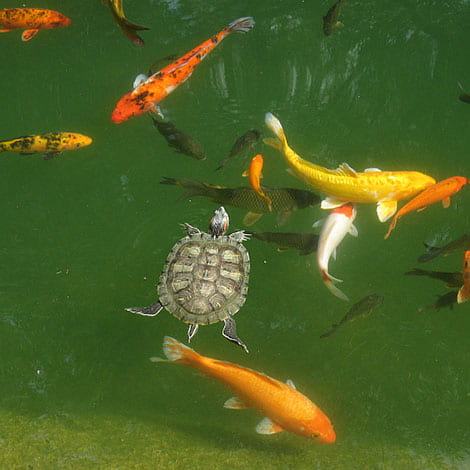Asked By: Beth of Casselberry, FL
A: Who isn't tired of battling algae!
Caused by excess fish waste and dead organics from leaves or previous algae blooms combined with excessive sunlight, all that garish green growth looks horrible, ruins your water quality, and creates a headache for you and your fish.
Is an
ultraviolet clarifier the answer? It depends on the type of algae you're trying to destroy.
Know Your Algae
The algae that forms in your pond comes in two basic flavors: planktonic and filamentous.
- Planktonic algae, the source of pea soup algae blooms, are floating, microscopic plants that color pond water shades of green, blue-green, brown or variations in between. In controlled amounts, this type of algae can actually be beneficial. It's considered the start of the pond food chain as the tiny plants feed fish inhabitants, and it can also shade the pond's bottom, preventing subsurface nuisance plants from growing. In uncontrolled amounts, however, planktonic algae can cause oxygen depletions and fish kill.
- Filamentous (string) algae are single-celled plants that form long, visible chain, threads or filaments. These threads, which start growing along the bottom of the pond in shallow water or on rocks or other aquatic plants, intertwine and form mats that resemble wet wool. When these mats rise to the surface, they're commonly referred to as pond scum. These mats make great homes for micro- and macro-invertebrates, like bugs and worms, but they're also unsightly.
UV clarifiers work by destroying the ultrafine planktonic algae – but, unfortunately, they do nothing to
combat the filamentous algae. You'll need a different strategy for the stringy stuff.
Battling Planktonic Algae
So how does ultraviolet light fight planktonic algae? When the algae cells are exposed to the bulb's ultraviolet rays, radiation destroys the plants' cellular walls. As a result, the tiny particles of dead algae clump together, and those clumps are then removed by your mechanical filtration system.
For the
UV Clarifier to work properly, however, follow these guidelines:
- Replace bulbs yearly. Worn-out bulbs – even if they still light up – may not be as effective at controlling green water.
- Watch your flow rate. Pushing water past the UV too fast can damage the unit and not allow enough contact time with the UV bulb for it to be effective.
- Don't flow too slow. Running a UV at too slow of a flow will act as a sterilizer and may also have a negative affect on natural bacteria meant to help decompose dead organics and fish waste.
Finding Balance
If you have an algae problem, be it planktonic or filamentous, it indicates your pond is out of balance. An ultraviolet clarifier should actually be one of your last tactics! Add some beneficial bacteria from the
DefensePAC Pond Care Package to help reduce the amount of organics in your pond. Start aerating the water. Consider using pond dye. If you have a thriving fish population, think about finding a new home for them (but don't release them into the wild!). Manage the nutrients, sunlight and oxygen levels, and your algae proliferation should naturally level out on its own.
Last Updated: February 1, 2023

